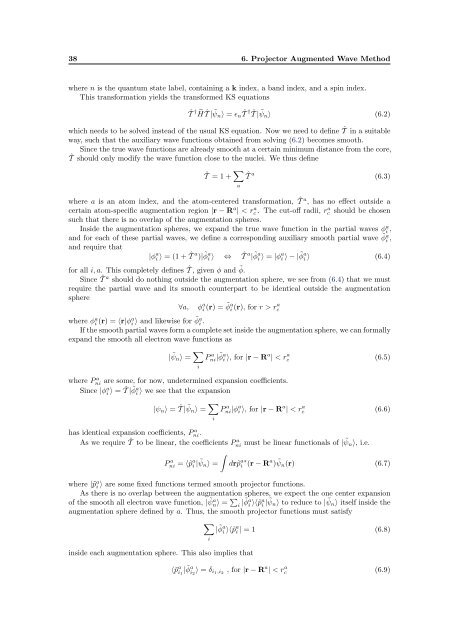Exact Exchange in Density Functional Calculations
Exact Exchange in Density Functional Calculations
Exact Exchange in Density Functional Calculations
Create successful ePaper yourself
Turn your PDF publications into a flip-book with our unique Google optimized e-Paper software.
38 6. Projector Augmented Wave Methodwhere n is the quantum state label, conta<strong>in</strong><strong>in</strong>g a k <strong>in</strong>dex, a band <strong>in</strong>dex, and a sp<strong>in</strong> <strong>in</strong>dex.This transformation yields the transformed KS equationsˆT † Ĥ ˆT | ˜ψ n 〉 = ɛ n ˆT† ˆT | ˜ψn 〉 (6.2)which needs to be solved <strong>in</strong>stead of the usual KS equation. Now we need to def<strong>in</strong>e ˆT <strong>in</strong> a suitableway, such that the auxiliary wave functions obta<strong>in</strong>ed from solv<strong>in</strong>g (6.2) becomes smooth.S<strong>in</strong>ce the true wave functions are already smooth at a certa<strong>in</strong> m<strong>in</strong>imum distance from the core,ˆT should only modify the wave function close to the nuclei. We thus def<strong>in</strong>eˆT = 1 + ∑ aˆT a (6.3)where a is an atom <strong>in</strong>dex, and the atom-centered transformation, ˆT a , has no effect outside acerta<strong>in</strong> atom-specific augmentation region |r − R a | < rc a . The cut-off radii, rca should be chosensuch that there is no overlap of the augmentation spheres.Inside the augmentation spheres, we expand the true wave function <strong>in</strong> the partial waves φ a i ,and for each of these partial waves, we def<strong>in</strong>e a correspond<strong>in</strong>g auxiliary smooth partial wave ˜φ a i ,and require that|φ a i 〉 = (1 + ˆT a )| ˜φ a i 〉 ⇔ ˆT a | ˜φ a i 〉 = |φ a i 〉 − | ˜φ a i 〉 (6.4)for all i, a. This completely def<strong>in</strong>es ˆT , given φ and ˜φ.S<strong>in</strong>ce ˆT a should do noth<strong>in</strong>g outside the augmentation sphere, we see from (6.4) that we mustrequire the partial wave and its smooth counterpart to be identical outside the augmentationsphere∀a, φ a i (r) = ˜φ a i (r), for r > rcawhere φ a i (r) = 〈r|φa i 〉 and likewise for ˜φ a i .If the smooth partial waves form a complete set <strong>in</strong>side the augmentation sphere, we can formallyexpand the smooth all electron wave functions as| ˜ψ n 〉 = ∑ iP a ni| ˜φ a i 〉, for |r − R a | < r a c (6.5)where Pni a are some, for now, undeterm<strong>in</strong>ed expansion coefficients.S<strong>in</strong>ce |φ a i 〉 = ˆT | ˜φ a i 〉 we see that the expansion|ψ n 〉 = ˆT | ˜ψ n 〉 = ∑ iP a ni|φ a i 〉, for |r − R a | < r a c (6.6)has identical expansion coefficients, Pni a .As we require ˆT to be l<strong>in</strong>ear, the coefficients Pni a must be l<strong>in</strong>ear functionals of | ˜ψ n 〉, i.e.∫Pni a = 〈˜p a i | ˜ψ n 〉 = dr˜p a∗i (r − R a ) ˜ψ n (r) (6.7)where |˜p a i 〉 are some fixed functions termed smooth projector functions.As there is no overlap between the augmentation spheres, we expect the one center expansionof the smooth all electron wave function, | ˜ψ n〉 a = ∑ i | ˜φ a i 〉〈˜pa i | ˜ψ n 〉 to reduce to | ˜ψ n 〉 itself <strong>in</strong>side theaugmentation sphere def<strong>in</strong>ed by a. Thus, the smooth projector functions must satisfy∑| ˜φ a i 〉〈˜p a i | = 1 (6.8)<strong>in</strong>side each augmentation sphere. This also implies thati〈˜p a i 1| ˜φ a i 2〉 = δ i1,i 2, for |r − R a | < r a c (6.9)












